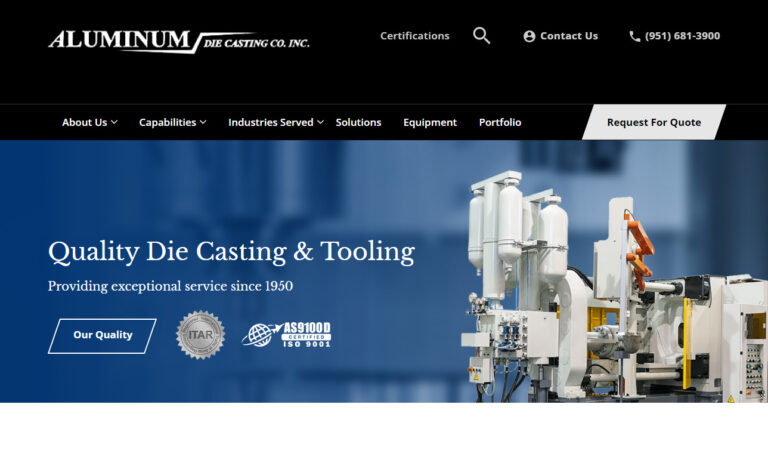The 5-Second Trick For Aluminum Castings Company
Table of ContentsUnknown Facts About Aluminum Castings CompanyHow Aluminum Castings Company can Save You Time, Stress, and Money.The Definitive Guide to Aluminum Castings CompanyExcitement About Aluminum Castings CompanyAluminum Castings Company Fundamentals Explained3 Easy Facts About Aluminum Castings Company ExplainedUnknown Facts About Aluminum Castings CompanyThe Buzz on Aluminum Castings Company
There are two main kinds of die spreading utilized in the light weight aluminum spreading market: hot chamber die spreading and chilly chamber pass away casting. The main difference between these methods is exactly how the molten steel is provided to the mold. In hot chamber die casting, typically made use of for lower melting point metals, the fusion is directly linked to the device, and a plunger requires the product with a gooseneck into the die tooth cavity.
Getting My Aluminum Castings Company To Work
In these methods, the mold and mildew is intentionally damaged or damaged away in order to draw out the finished aluminum casting. Typical procedures under the classification of expendable mold casting include (investment casting),,, and investment spreading. When producing custom-made aluminum components utilizing expendable molds, producers put liquified light weight aluminum or light weight aluminum alloys into the mold, which is after that damaged apart to launch the solidified steel component.
The is just one of the oldest and most favored kinds of light weight aluminum spreading. It involves compacting specialty factory sand, frequently reinforced with clay or resin, around a precisely crafted multiple-use pattern that establishes the form and interior details of the finished light weight aluminum item. The pattern system incorporates risers and vents to handle the flow of molten steel and to avoid casting flaws such as contraction porosity.
Not known Incorrect Statements About Aluminum Castings Company

This mold is then preheated before the putting of molten light weight aluminum or light weight aluminum alloy. As the steel loads the covering, it records the complex details and great surface area finish of the mold and mildew. When cooled, the ceramic is mechanically or chemically escaped, enabling for the removal and separation of individual actors parts.
Examine This Report about Aluminum Castings Company
Irreversible mold and mildew casting uses reusable metal molds and is optimal for automation with regular quality and less waste. Expendable mold and mildew casting utilizes single-use mold and mildews, like sand or foam, providing style versatility and reduced tooling expenses for models or brief runs. Pass away spreading is best for generating high volumes of aluminum components that require tight tolerances, great information, and smooth surface areas.
The Toshiba Equipment DC-J Series includes die casting makers appropriate for light weight aluminum. Recognized for their durable construction and high injection efficiency, these makers guarantee efficient and precise casting (Aluminum Foundry).

While light weight see this site aluminum can be used in its pure form, it is commonly alloyed with various other steels to boost its homes or the residential properties of the various other steels. These alloys offer improved performance for different applications. Aluminum alloys are categorized into eight collection, phoned number from one to eight. The first figure(s) of the number indicate the key alloying aspect integrated with light weight aluminum.
Aluminum Castings Company Things To Know Before You Get This
This alloying improves the strength and solidity of aluminum but lowers its ductility and rust resistance. The 2000 collection alloys are challenging to weld however can be heat dealt with to enhance their homes. The 3000 collection alloys are largely alloyed with manganese. This mix boosts rust resistance while providing modest stamina.
The 4000 series alloys are alloyed with silicon, which decreases the melting point and improves fluidness. This makes it a popular option for spreading, as it is easy to create in its molten state.
The Greatest Guide To Aluminum Castings Company
This series is categorized as a high-strength alloy, especially fit for sheet and plate applications due to its outstanding weldability. Its resistance to corrosion from acids and antacid makes it perfect for usage in rough and aggressive settings (Metal Castings). The 6000 series alloys are alloyed with both magnesium and silicon, offering a balance of stamina, mechanical properties, and rust resistance
Processing the 6000 collection requires specialized and sophisticated devices, which can be intricate and expensive. This series is recognized for its superb rust and oxidation resistance, as well as its simplicity of finish, treatment, and workability. The 7000 collection light weight aluminum alloys are the greatest and most durable among aluminum types, with toughness similar to about two-thirds of industrial-grade A3 steel.
All About Aluminum Castings Company
Zinc is the main alloying component in the 7000 collection, boosting the hardness of the light weight aluminum, despite the fact that zinc's hardness is similar to that of light weight aluminum on the Mohs range. The 8000 collection light weight aluminum alloys are mostly alloyed with tin, in addition to percentages of copper and nickel (Aluminum Melting and Casting). While these alloys offer reduced strength contrasted to other collection, they stand out in machinability and wear resistance
Aluminum cast heatsinks are electrically conductive, permitting them to be grounded properly. They are frequently cast with incorporated features that lessen the demand for second operations, such as extra machining or setting up, bring about additional expense savings. Light weight aluminum spreading is often made use of to produce brackets for both durable commercial devices and household home appliances.
More About Aluminum Castings Company
The single-piece building and construction of aluminum braces boosts their toughness and durability, minimizing the likelihood of failing. If openings are called for, they can be consisted of straight in the spreading mold and mildew, reducing the need for post-production ending up (https://peatix.com/user/28269717/view). Producers have increasingly adopted aluminum spreading for golf equipment due to its sturdiness, security, and adaptability in shaping